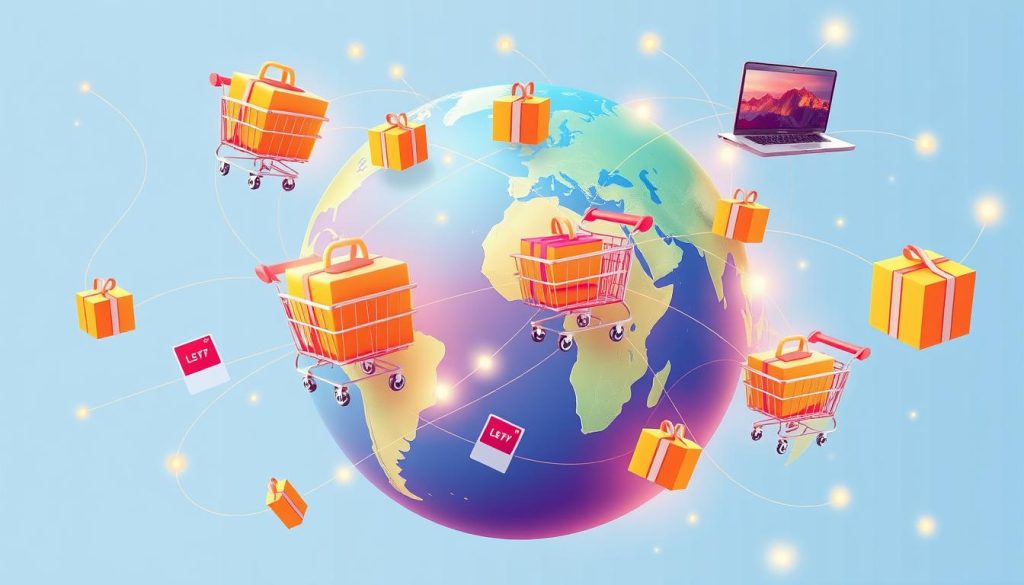The world of business has been transformed by e-commerce. This change has reshaped how we think about international business. Digital global marketplaces have opened doors for everyone to a worldwide audience, leading to a surge in international e-commerce growth. Now, both big companies and small artisans can sell globally from their digital shops.
Shoppers quickly embraced these online platforms, changing online consumer trends. The easy access and wide variety of choices have boosted online spending. This is part of the big changes in e-commerce market trends. This move to digital is more than convenient; it changes jobs and how people buy things worldwide.
E-commerce is more than just buying and selling online. It’s key for businesses wanting to grow globally. Trade and commerce have escaped their physical bounds. They now thrive in a limitless digital space.
Key Takeaways
- The rise of e-commerce represents a fundamental change in international trade.
- Digital marketplaces have enabled businesses of all sizes to reach global audiences.
- There has been significant international e-commerce growth, altering online consumer trends.
- E-commerce market trends suggest a sharp increase in consumer spending and market diversity.
- The influence of e-commerce extends beyond sales to cause wider socio-economic impacts.
The Advent of E-Commerce in Global Trade

The world of international trade has drastically changed due to digital tech, especially because of e-commerce. This change has not only transformed how companies work but also their approach to global markets.
Understanding the Digital Transformation
The shift to digital has revolutionized several industries, putting e-commerce in the spotlight. Moving from physical stores to online marketplaces has cut the cost and complexity of global trade. It has also made the economy more open, letting small businesses reach customers worldwide.
The Role of E-Commerce Platforms in Cross-Border Trade
Platforms like Amazon, Alibaba, and eBay have been key in this shift. They offer the needed setup for international e-commerce and work to break down common trade barriers. By making the trade process simpler, they help businesses tackle regulatory, cultural, and economic challenges more smoothly.
- Reduction of physical borders enhances consumer access to foreign markets.
- Streamlined operations simplify the complexities involved in international logistics.
- Digital payment systems integrated into these platforms facilitate secure and swift transactions across different currencies.
This progress leads to a dynamic world market, lowering entry barriers and opening up huge growth chances. As these platforms evolve, businesses have greater opportunities to innovate and expand globally online.
E-Commerce and Its Impact on Market Dynamics

The digital era has transformed shopping, causing major shifts in consumer habits and the retail world. Now, businesses face a tough challenge. They must cater to digital-first consumers and also make the most of new retail opportunities.
Shifting Consumer Behaviours and Expectations
With the growth of e-commerce, shoppers today expect convenience, quick service, and a shopping experience that’s just for them. This demand for better online shopping has led to innovations. Retailers are now blending the feel of in-store browsing with online shopping’s ease.
By using cutting-edge technology, companies can gather and analyse customer data. This lets them offer unique shopping experiences and build stronger customer loyalty.
Challenges and Opportunities for Traditional Retailers
The rise of e-commerce has changed the game for traditional retailers. Their biggest task? To blend their physical stores with the digital world smoothly. Despite these challenges, the digital era offers many chances for growth.
Embracing omnichannel strategies helps traditional retailers reach more customers. This approach gives shoppers a more versatile experience. This can lead to higher sales and more satisfied customers.
In summary, while e-commerce brings challenges to traditional retailers, it also provides chances for advancement. Success lies in using online and offline channels together. Adapting to these shifts is crucial for staying ahead in the digital market.
Cross-Cultural E-Commerce Challenges

The world of e-commerce is growing fast, reaching customers all over the globe. But, businesses face many challenges when they enter foreign markets. It’s important for companies to understand these issues. They need to do this if they want to increase their influence worldwide.
Adapting to different cultures is a big hurdle in international e-commerce. Companies must understand different cultural norms and buying habits. They need to tailor their marketing to match local preferences. This task can be tough, but it’s vital for gaining ground in new areas.
- Language differences that impact communication and customer service.
- Payment preferences varying significantly across different regions.
- Legal and regulatory requirements that vary by country.
Also, companies must have strong logistical plans and infrastructure for global shipping. They need to make sure they can deliver products across borders effectively. This adds another level of challenge to their work.
In the end, the difficulties of cross-cultural business are big, but they can be overcome. Businesses that adjust to various needs will not only succeed but also help shape the future of global e-commerce. Being aware of and tackling these obstacles is key for any company aiming for global success.
E-Commerce Logistics: Redefining Supply Chains

The e-commerce world is always changing. It’s making traditional supply chains better and more efficient. At the heart of this change is the smart use of new delivery methods. These methods are friendly to the planet, especially in how things are packaged.
Innovation in Packaging and Delivery
Packaging in e-commerce is not just about looking good. It’s about working well and not harming the environment. Companies use new tech to make sure products arrive safely. They also make sure the packaging does little harm to our world. This includes things that break down naturally to smart packaging. Smart packaging checks the temperature and moisture while items are shipped.
- Using materials that have been recycled to lessen waste.
- Making packaging that people can send back or use again.
- Smart packaging that keeps products fresh longer and prevents damage.
Impact of Last-Mile Delivery on Customer Satisfaction
Last-mile delivery hugely affects how happy customers are. It’s the final step in getting goods to customers. This stage is vital because it’s the big moment customers wait for. Making this part better can make deliveries faster. It can also make things cheaper and clearer for customers. All this makes customers more loyal and happy.
- Using clever route planning software to speed up deliveries.
- Working with local services to get things delivered faster and farther.
- Offering live updates so customers know where their order is.
In conclusion, e-commerce firms are always updating their supply chains for better delivery. They’re choosing eco-friendly packaging and making last-mile deliveries better. By doing these things, they are becoming more efficient. They’re also making their customers happier and staying ahead of competitors.
The Importance of Data Analytics in E-Commerce

Today, e-commerce data analytics is key in the digital market. It shapes unique online shopping experiences and improves business operations. By using customer data well, companies can boost their market plans and make shoppers happier.
Predictive analytics helps predict future shopping trends and behaviors by looking at past and present data. This means retailers can better handle their stock, know what products will be in demand, set the right prices, and plan their marketing better.
- Analyse customer interactions to make shopping more personal, increasing engagement and loyalty.
- Use data insights to make better product suggestions, helping with upselling and cross-selling.
- Improve supply chain efficiency by predicting busy times, ensuring products are available and delivered on time.
In a changing digital commerce world, the role of e-commerce data analytics grows even bigger. Companies that use customer data insights well are more likely to lead and succeed online. Basically, using this data creates a shopping environment that is lively, quick to react, and personal. It makes sure businesses meet customer needs well.
Payment Systems and Cybersecurity in Online Transactions

Today, keeping online financial transactions safe is key to e-commerce growth across the globe. With new payment technologies, businesses aim to add secure payment methods and improve e-commerce security. This effort helps keep consumer data safe.
The rise in online shopping brings more cyber threats. Having strong security is vital. It keeps shoppers’ trust and makes sure e-commerce sites run well.
Enhancing Payment Security for International Transactions
To protect international transactions, many safety steps are needed. These include advanced tech and following global rules. Features like encrypted data, strong login checks, and checking for frauds are part of secure payment options.
- Encryption technologies to secure transaction data
- Two-factor authentication for added security checks
- Real-time fraud detection systems to prevent unauthorized access
The Evolution of Digital Wallets and Cryptocurrencies
Digital wallets and cryptocurrencies are changing the way we shop online. Digital wallets make payments easy and safe. Cryptocurrencies are a new option. They are not controlled by any bank and can have lower fees.
- Increased adoption of digital wallets for seamless payment processes
- Integration of cryptocurrencies in e-commerce as a means to reduce costs and enhance privacy
As these payment methods grow, boosting e-commerce security is critical. Constant updates in payment security not only protect transactions. They also make shoppers feel safer. This leads to more growth in online shopping.
Regulatory Frameworks Governing International E-Commerce

Moving through the world of international e-commerce requires knowing a lot about different rules worldwide. It’s key to know about international e-commerce regulations, cross-border e-commerce laws, digital trade policies, and compliance in online business for success online.
Each country has its own rules that affect e-commerce businesses working across borders. These not only deal with economic aspects but also ensure consumer protection, data privacy, and fair trading.
With the increasing complexity of international markets, knowing digital trade laws is crucial for running an e-commerce business in various countries.
Compliance in online business matters a lot because ignoring it can lead to big fines, business problems, or legal issues. Here’s how to stay compliant:
- Keep up to date with changes in digital trade policies in all the markets you work in.
- Set up strong systems for handling cross-border sales according to international e-commerce regulations.
- Make sure your business methods meet international data protection standards.
- Work with legal experts to get the details on cross-border e-commerce laws.
Clearly, knowing these regulations is vital not just for legal reasons. It also helps build trust and solid relations with customers worldwide.
Key Trends in International Business Is the Rise of E-Commerce

E-commerce has changed a lot, becoming a key trend in online business. It’s easier for shoppers now, and businesses are using new strategies. They look at what works in e-commerce to succeed.
Case Studies: Companies Thriving Through E-Commerce
Many brands have grown worldwide by using the internet. They use clever marketing and strong online platforms. This lets them reach more people and grow a lot.
- Increased reach to a global audience without the need for physical stores.
- Enhanced customer data analysis leading to more targeted and effective marketing strategies.
- Streamlined operations with integrated logistics solutions.
The Growth of Mobile Commerce and Its Effects
More people shop on their phones now, changing how we buy things. Phones make shopping easy, changing old shopping ways fast.
- Enhanced user interfaces on mobile apps lead to increased customer conversion rates.
- Location-based promotions and services are becoming more prevalent and effective.
- Integration of AR and AI technologies in mobile apps to enrich the shopping experience.
Mobile tech and e-commerce are coming together in exciting ways. Businesses focusing on mobile can beat others and find new customers.
Consumer Trust and Brand Loyalty in E-Commerce

The digital marketplace is built on consumer trust and brand loyalty online. This section looks at how businesses can build trust and encourage customers to return. It shows strategies to make users believe in and stick with their brand.
Building Trust Through Customer Reviews and Social Proof
Customer reviews significantly shape trust in e-commerce. These testimonials show transparency and convince new users to trust the brand. Social proof, from reviews, influencer endorsements, or media mentions, boosts reliability and trust.
93% of consumers say online reviews impact their purchasing decisions. — Source: Consumer Data Survey
By displaying reviews, companies can greatly increase consumer trust. This leads to more sales and builds a community around their brand.
The Role of Personalisation in Enhancing User Experience
Nowadays, personalisation is key to great customer service in e-commerce. Making the shopping experience unique to each user boosts loyalty. It makes the user’s experience better and deepens brand loyalty.
- Personalised homepages based on browsing history
- Targeted discounts offers through email marketing
- Custom product recommendations using past purchase data
These methods make customers feel special and understood. So, they are more likely to come back. This personal touch greatly helps in keeping customers loyal and trusting the brand.
The Intersection of E-Commerce and Sustainability

As online shopping grows, so does the focus on sustainable e-commerce practices. The rise of eco-friendly online business is essential for the future of retail. This shift towards sustainability reflects in consumer preferences, influencing how people choose to buy.
Adopting sustainability trends in e-commerce touches many areas. These include product sourcing, packaging, and delivery. Embracing sustainability not only helps the planet. It also sets a brand apart in today’s competitive marketplace.
- Biodegradable packaging materials are increasingly used to lessen waste.
- Sourcing products locally cuts down on carbon emissions and boosts local economies.
- Using less electricity in logistics and warehouses reduces emissions.
- Recycling programmes for old products boost sustainability.
Eco-friendly online businesses are meeting the demands of eco-conscious shoppers and leading the way in sustainable e-commerce practices. Their focus on sustainability is changing how we see, value, and buy products online.
By integrating sustainability into their models, e-commerce sites boost their allure while helping the planet. This blend of eco-friendly business practices is redefining the digital market. It creates a savvy, environmentally conscious customer base.
To wrap up, as e-commerce evolves, incorporating sustainable methods is crucial. It’s not just about helping the environment but also crucial for business success. This merging of e-commerce and sustainability is forging a new path in digital shopping. It’s opening up an era of eco-friendly consumerism.
AI and Machine Learning: Revolutionising E-Commerce

AI is changing how people shop online. With machine learning, systems can guess what users like and make buying and selling smoother. This leads to happier customers and more profits.
Chatbots and virtual assistants in e-commerce show how AI is used. They automate talks, are there for customers any time, and make shopping personal for lots of people at once.
Personalised Shopping Experiences with AI
E-commerce sites use machine learning to give shopping tips that really fit what you like. They look at what you’ve browsed and bought before to recommend items you might want.
Automating Customer Service with Chatbots and Virtual Assistants
Chatbots and virtual assistants are key in handling questions and problems from customers. They learn from each chat and are getting better at answering tough questions, which used to need a human.
- They answer customers right away, solving problems faster and making customers happier.
- They’re available 24/7, so customers get help anytime, not just during office hours.
- They handle more customers when it’s really busy, without needing more staff.
The growth of AI shows it could change all parts of e-commerce, showing why it’s critical to use new tech to stay in the game.
Emerging Markets and E-Commerce Expansion

The rise of new e-commerce markets offers opportunities and challenges for global growth. As more people get online and shop on the internet, it’s important to know about local markets. We look at the strategies that help succeed in these lively but complex markets.
Understanding Localised Strategies for Market Entry
Localising e-commerce isn’t just translating to a local language. It’s also about tailoring marketing and products to fit the local culture, buying habits, and laws. A good strategy understands regional differences to connect with and engage local shoppers.
- Adaptability in product and service offerings to meet local tastes and preferences.
- Collaborative ventures with local businesses to bolster market presence and credibility.
- Strategic use of local influencers and social media to build brand familiarity and trust.
The Impact of Internet Penetration on E-Commerce Growth
As connectivity grows, the link between internet access and e-commerce growth is clear. More people online means a bigger market for digital shopping. This makes new e-commerce markets ripe for investment.
As connectivity improves, so does the propensity for consumers to explore online shopping, bringing a slew of digital-first shoppers into the fold.
Companies need to scale up their digital setup to meet increasing demand. They must reach more people and offer great online experiences. This is vital to attract and keep customers in a competitive field.
The Future of E-Commerce: Trends to Watch
Anticipating future e-commerce trends is crucial for online retail success. Integration of online retail innovations and technologies is becoming important. This offers convenience and personalised shopping experiences. Using predictive e-commerce analytics will change the game. It allows retailers to predict customer behaviour more accurately and offer tailored products.
The rise of virtual reality shopping is changing how we buy online. It offers immersive product demos and interactive environments. This means you can have a store-like experience without leaving your home. Virtual reality reduces doubts about online shopping. It also makes digital shopping more trustworthy and engaging.
Future e-commerce relies on being highly adaptable. It will use smart analytics for real-time supply chain changes and dynamic pricing. To stay ahead, businesses need to integrate these online retail innovations. They must focus on efficient, enriched, and proactive strategies. The changes in e-commerce will be exciting for shoppers and businesses.











